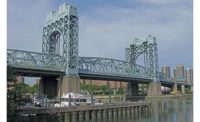After 104 years, the steel wheels that roll and engage weights on Portland’s Broadway Bridge are about to be history. The size and weight of the new wheels and their rails as well as the need to keep traffic moving are complicating the project, set to begin this month.
“We thought it was going to be pretty challenging, but we found that the way the bridge was put together was a little different [than we thought] and it will be more challenging,” says Jon Henrichsen, bridge services manager for the owner, Multnomah County.
The double-leaf drawbridge spanning the Willamette River, which was designed by Ralph Modjeski, uses a lift system with so-called Rall wheels after the inventor Theodor Rall. The four 8-ft-dia wheels support the 2,250-ton weight of each opening span.
Suppliers have already created four new wheels. Crews will start the replacement process for the wheels, tracks and shafts on Aug. 15. The $13.5-million project, which requires lane closures, will last into the fall.
The 1913 bridge is the largest of its type in the world, the seventh-longest bascule bridge and only one of three remaining Rall bridges in use in the U.S. The mechanism allows the old nickel-chrome-steel casting wheels of 13.8 tons each to roll back and engage weights that lift the two center spans.
This bridge type opens faster, higher and uses less energy than other bridges of its era, says Henrichsen. But the bridge’s advanced age presents rehabilitation challenges, he adds.
The county entered into a construction manager/general contractor contract with designer Hardesty & Hanover and contractor Hamilton Construction based on qualifications. The negotiations took longer than expected because of the project’s complexity. That in turn delayed the start of the site work, originally set for May.
The bridge has three gusset plates over the wheels that engineers thought were each attached to bridge beams. But the middle gusset is not. Crews will need to ensure they push farther into the interior of the truss to make the connection and discourage temporary sagging.
“When we started digging into taking the wheels off and getting them in the air, you find things like that,” Henrichsen says.
Forged and Machined
Instead of copying the old-style wheels, which were cast in three pieces and welded together to create interior webs, the team opted to forge steel and machine the wheels down to a final shape.
At 44 tons each, the new wheels weigh more than three times the originals. Under a $4.4-million contract, Vigor Works forged the new wheels with ASTM A668 steel from Ohio and machined them in Portland. The forging was finished early in the project. New wheel tracks, ready for installation, are also made from forged steel and are heavier than the original tracks.
“Both the wheel and track systems are highly machined [due to the size and style],” says Thomas Hickman, Vigor’s vice president. “It took nearly 6,000 hours of machining to produce the finished product,” he adds.
Each of the four wheels moves on a 2-ft-thick track system that is 32 ft, 8 in. long and 3 ft, 8 in. wide. Each wheel rotates on a 2-ft, 4-in.-dia pin.
Vigor made the large components in its Clackamas, Ore., plant and then transported them by special carrier to its Swan Island plant in Portland. There the components were barged to the site and delivered to Hamilton Construction.
Vigor worked with North American Forgemasters to forge the raw blanks of solid steel and then subcontracted some of the work to Peninsula Iron Works, Portland, for machining. “Here we precision-machined each of the wheels and track assemblies to finish tolerances required by the owner,” Hickman says.
The weight of the wheels does not affect the balance on the lift span or counterweight. Inspections found the truss and foundations can handle the additional weight, Henrichsen says.
The design and configuration of the forged replacement Rall wheels and tracks required a configuration change of the wheels and tracks to facilitate installation constraints of working on a preexisting bridge, says Frank Marzella, principal associate with Hardesty & Hanover. At the same time, the engineer had to maintain the historic appearance.
Bridge Jacking
To make way for the new system, Marzella says the jacking and temporary support system required a complex method of lifting and supporting the bridge. “Multiple concepts were developed and vetted,” he says.
Ultimately, a shoring post design was fully developed that transfers the large wheel loads through the roadway deck to the concrete pier cap below.
The bridge will receive adjustable three-piece control struts that attach to the counterweight and tracks.
“Because we are putting in new wheels and adjusting everything to an ideal elevation and ensuring the same shape as it rolls back and forth, we are replacing control struts with adjustable [versions] to make sure it all moves,” he says.
The counterweights must move in an arc when the wheels roll, and by adding heavier wheels, the design required the addition of an adjustable strut to ensure the proper arc. The new three-piece strut component bolts two end pieces with pins to the adjustable section in the center that can shim to lengthen or shorten as needed. “It is not a major issue, just something engineers realized as they dug into the plans,” Henrichsen says.
Work can be performed when it rains, and there is no work from the river itself. But the contractor had to find times when the bridge leaves could remain closed. It takes about 20 minutes to open the bridge, which happens about 25 times each month. During construction, the plan is to open one span at a time so the other can be rehabilitated.
The bridge mostly opens for ships headed for a large grain terminal on the south side and for any other ocean-going vessels sailing up the Willamette toward the Columbia River. And the bridge needed to be operable for the arrival of fleets during Portland’s annual Rose Festival in June. The county agreed on dates with the grain terminal when it did not need the bridge open. That will give crews a 35- to 40-day window for the work.
On a typical day, as many as 30,000 vehicles cross the bridge. During construction, one center lane will remain open. Sidewalks, cycling lanes, streetcars and buses will be able to use the bridge during most of the project.
“The bridge is a vital link in the downtown Portland area,” Marzella says. “The construction requires complex staging and traffic control so that the work can be performed with minimal impacts to the public and commercial bridge users.”
Making Old New Again
Previously, crews had removed the lead paint from most of the 1,613-ft-long bridge, which is 70 ft wide. However, they could not get behind the wheels. This project will allow crews to remove the rest of the lead paint before replacement wheels are installed. The Broadway Bridge, historically painted black, was painted Golden Gate Red in 1963.
To prepare for construction, crews installed parts of the shoring and jacking system used to lift the first leaf.
“We are pretty confident, but it is a big, difficult job and not something people have really done before,” Henrichsen says. “We believe we have thought through the challenges, but I am sure we will find new ones as we open things up. It will be a relief to get the first one done and working correctly.”









Post a comment to this article
Report Abusive Comment